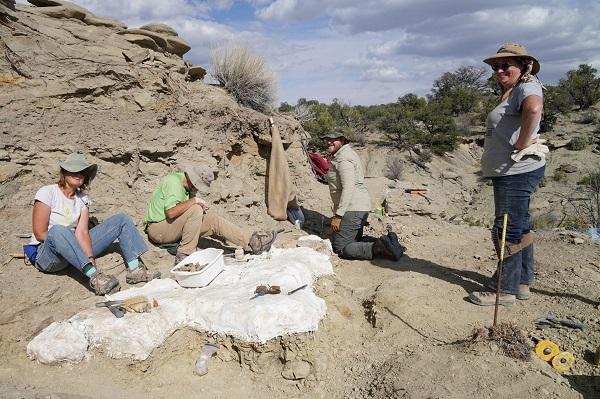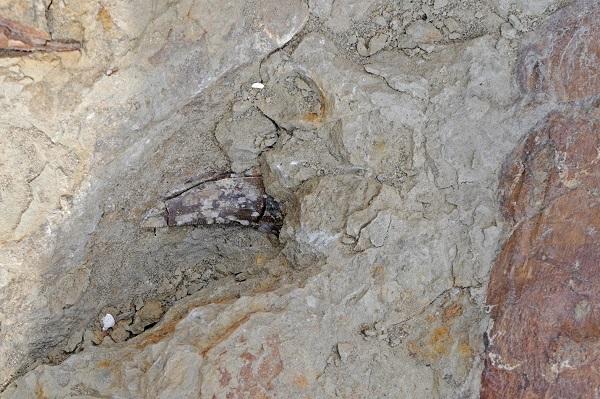You are viewing ARCHIVED content published online before January 20, 2025. Please note that this content is NOT UPDATED, and links may not work. Additionally, any previously issued diversity, equity, inclusion or gender-related guidance on this webpage should be considered rescinded. For current information, visit https://www.blm.gov/blog.
Grand Staircase-Escalante National Monument nets important dinosaur discovery
Story by David Hercher, Paria River District Public Affairs. Photos courtesy of Dr. Randy Irmis, Natural History Museum of Utah Chief Curator.
As a child, Taylor Barnette had always dreamed of finding dinosaurs, especially a Tyrannosaurus rex. Growing up in New Mexico, he would pretend to hunt for dinosaurs in the desert surrounding his home.
Fast forward to adulthood. Taylor has found himself fulfilling a lifelong dream— hunting for real dinosaurs as a volunteer for BLM Utah’s Grand Staircase-Escalante National Monument’s paleontology program.
In November 2018, Taylor stood on the ledge of 76-million-year-old sandstone near the top of a steep face, where he noticed bone fragments littered over the slope. This type of discovery was familiar to him as he had seen other dinosaur sites before, mostly of the common plant-eating hadrosaurs. This time, the discovery looked and felt different. That winter, he reported the site to Paria River District (PRD) Paleontologist Dr. Alan Titus, who agreed that the site sounded intriguing and worth exploring further.

When fieldwork resumed the following June, Scott Richardson, a seasonal field tech for the PRD, set out to look for and confirm the site, officially naming it TAB-18-2 (or T2 for short). The site preserved a large theropod dinosaur, believed to possibly be a T. rex. Richardson recommended that the site be excavated. Given the rarity of tyrannosaurs as fossils and that few specimens had been collected from the lower portion of the Kaiparowits Formation, Richardson thought there was a high probability the site could be significant.
To a paleontologist this translates to a site that is “significant enough that it is worthwhile to plan for and to commit additional resources toward in the interest of furthering scientific research because it will substantially increase our knowledge or will elucidate something new to science,” explained Titus.
The Monument paleo team’s initial work on the site began in the summer of 2020. By the end of the 2020 field season, it became apparent that the site contained an exceptionally large individual—in fact one of the largest ever found in the Kaiparowits Plateau (probably exceeding 30-feet-long in life)—with a good deal of the skeleton, including the skull, still in the ground.

Given the size of the animal and the fact that it was capped by a solid six-foot-thick wall of concrete-hard sandstone, the BLM turned to its longtime partner, Dr. Randy Irmis, and the Natural History Museum of Utah (NHMU), for help. When work resumed at the site in 2021, the first challenge was to push back the nearly impenetrable sandstone wall. The Museum’s volunteers picked and hammered day after day, eventually managing to push it back almost eight feet beyond its former limit. In so doing, they uncovered a trove of beautifully preserved bone from nearly every part of the animal’s body: skull, legs, backbone, tail and pelvis.
“The bone quality is as good as I’ve seen from the Kaiparowits,” said Dr. Irmis, Natural History Museum of Utah Chief Curator and Curator of Paleontology and Associate Professor of Geology and Geophysics, University of Utah.

So much bone is there that the team’s biggest challenge so far has been trying to find ways to split the specimen into blocks of manageable size.
“Right now, if I just capped everywhere there is high density bone, I’d have a single block weighing about 5 tons, which we could never get out of this remote location,” said Tylor Birthisel, NHMU’s lab and field program manager.
Undaunted by the logistics, the museum team will be back in 2022 to try and solve this puzzle, as well as the many other challenges that come with retrieving such an important specimen from the rugged Kaiparowits Plateau, and getting it ready for scientific research. A team including Dr. Irmis is currently trying to determine if there might be second new species of tyrannosaur in the Kaiparowits Formation and this new specimen will certainly be important for answering that question.
“There is such vast potential for the Monument to help paleontologists answer some big-picture questions on evolution and extinction,” said Dr. Irmis. “It really is the ideal outdoor laboratory. Specimens like these are important pieces of a much larger puzzle—collecting, studying, and preserving them is important for both science and the public.”
This “T2” excavation is part of a cooperative partnership between the BLM, the Natural History Museum of Utah, and a collective army of paleo volunteers—the proverbial backbone of the Grand Staircase-Escalante National Monument paleontology program. The volunteers have tirelessly helped excavate and prepare specimens of more than a dozen new species within the fossil-rich badlands of the Kaiparowits Plateau for over 25 years, many of which have yet to be prepared for scientific research.
For more information about the Grand Staircase-Escalante National Monument Paleo Volunteer Program, please contact Katja Knoll at: [email protected].
Check out these paleo materials from Grand Staircase-Escalante National Monument from 2021:
- Dino dentistry extracts paleo story from public land
- Evidence indicates Tyrannosaurs may not have been a solitary species after all
- GSENM 25th Anniversary Audio Series
- GSENM 25th Anniversary Video Science Series
- Teratophoneus Social Behavior Research Press Kit
- The Rainbows & Unicorns Quarry
- Geology and taphonomy of a unique tyrannosaurid bonebed from the upper Campanian Kaiparowits Formation of southern Utah: implications for tyrannosaurid gregariousness
David Hercher, Paria River District Public Affairs
Related Stories
- BLM Fire and National Conservation Lands managers collaborate to meet shared goals
- BLM delivers on administration priorities
- More than a summer threat: Protecting public lands from fall fires
- Building for birds: Scouts support public lands
- BLM announces 2025 Rangeland Stewardship and Innovations Award winners
